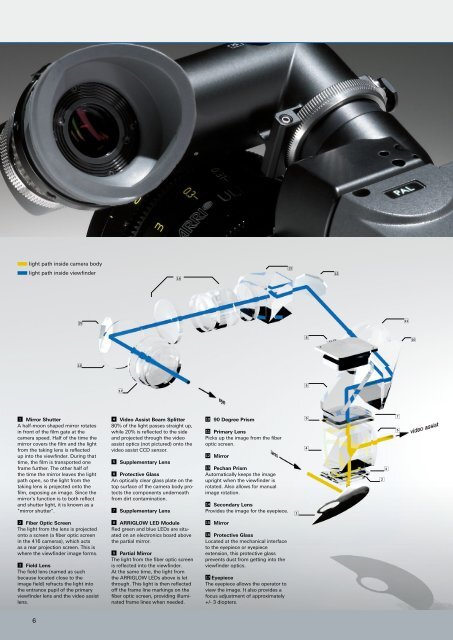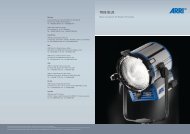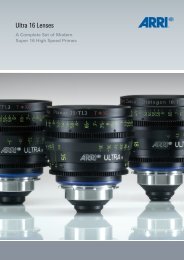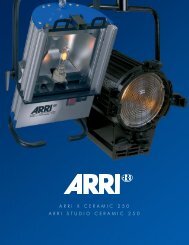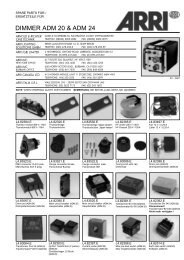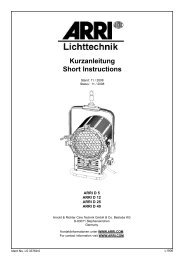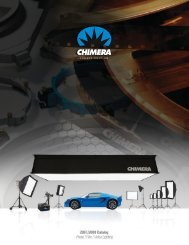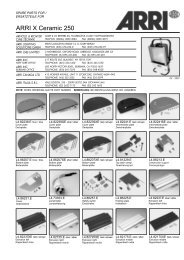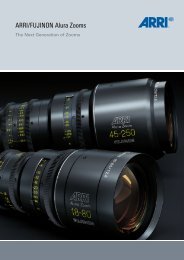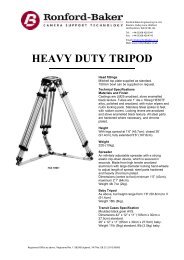ARRIFLEX 416 - Arri CSC
ARRIFLEX 416 - Arri CSC
ARRIFLEX 416 - Arri CSC
Create successful ePaper yourself
Turn your PDF publications into a flip-book with our unique Google optimized e-Paper software.
z light path inside camera body<br />
z light path inside viewfinder<br />
AN<br />
AM<br />
AL<br />
AO<br />
AK<br />
AT<br />
AP<br />
AQ<br />
9<br />
u Mirror Shutter<br />
A half-moon shaped mirror rotates<br />
in front of the film gate at the<br />
camera speed. Half of the time the<br />
mirror covers the film and the light<br />
from the taking lens is reflected<br />
up into the viewfinder. During that<br />
time, the film is transported one<br />
frame further. The other half of<br />
the time the mirror leaves the light<br />
path open, so the light from the<br />
taking lens is projected onto the<br />
film, exposing an image. Since the<br />
mirror's function is to both reflect<br />
and shutter light, it is known as a<br />
"mirror shutter".<br />
v Fiber Optic Screen<br />
The light from the lens is projected<br />
onto a screen (a fiber optic screen<br />
in the <strong>416</strong> cameras), which acts<br />
as a rear projection screen. This is<br />
where the viewfinder image forms.<br />
w Field Lens<br />
The field lens (named as such<br />
because located close to the<br />
image field) refracts the light into<br />
the entrance pupil of the primary<br />
viewfinder lens and the video assist<br />
lens.<br />
x Video Assist Beam Splitter<br />
80% of the light passes straight up,<br />
while 20% is reflected to the side<br />
and projected through the video<br />
assist optics (not pictured) onto the<br />
video assist CCD sensor.<br />
y Supplementary Lens<br />
U Protective Glass<br />
An optically clear glass plate on the<br />
top surface of the camera body protects<br />
the components underneath<br />
from dirt contamination.<br />
V Supplementary Lens<br />
W ARRIGLOW LED Module<br />
Red green and blue LEDs are situated<br />
on an electronics board above<br />
the partial mirror.<br />
X Partial Mirror<br />
The light from the fiber optic screen<br />
is reflected into the viewfinder.<br />
At the same time, the light from<br />
the ARRIGLOW LEDs above is let<br />
through. This light is then reflected<br />
off the frame line markings on the<br />
fiber optic screen, providing illuminated<br />
frame lines when needed.<br />
at 90 Degree Prism<br />
ak Primary Lens<br />
Picks up the image from the fiber<br />
optic screen.<br />
al Mirror<br />
am Pechan Prism<br />
Automatically keeps the image<br />
upright when the viewfinder is<br />
rotated. Also allows for manual<br />
image rotation.<br />
an Secondary Lens<br />
Provides the image for the eyepiece.<br />
ao Mirror<br />
ap Protective Glass<br />
Located at the mechanical interface<br />
to the eyepiece or eyepiece<br />
extension, this protective glass<br />
prevents dust from getting into the<br />
viewfinder optics.<br />
aq Eyepiece<br />
The eyepiece allows the operator to<br />
view the image. It also provides a<br />
focus adjustment of approximately<br />
+/- 3 diopters.<br />
6


